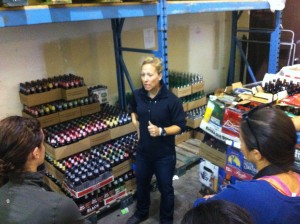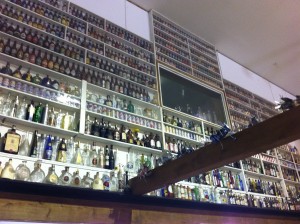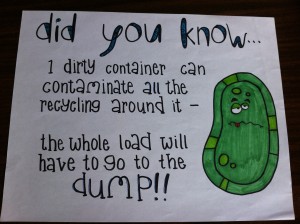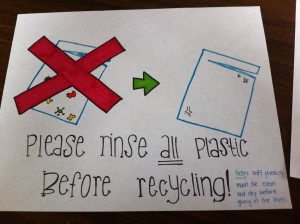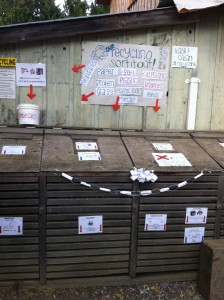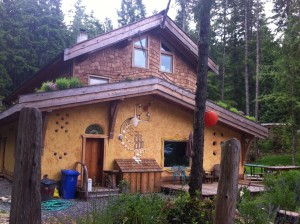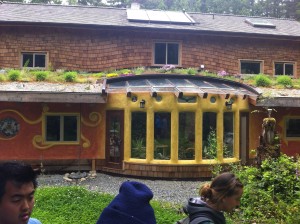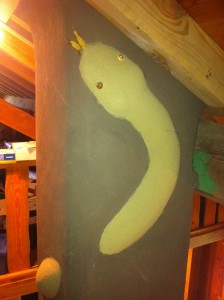One of the big projects we were working on during our stay at the Ecovillage was redoing the current recycling system. Since the MMBC (mixed materials BC) was introduced, a lot of changes have been made as to what can or cannot be recycled. We went on a tour of the Return-It Depot in Duncan in order to get a better understanding of the current recycling system.
This is the woman who gave us the tour. She was so full of information! At this point, she was explaining that not all glass bottles are recycled – some are refilled. These require a lot less energy and resources than melting down bottles to create new ones. We also learned that the little dots on the bottom of some glass bottles indicate how many times that bottle has been refilled.
The recycling depot had walls that were full of old, interesting bottles, as well as many air planes made of pop cans – a great example of salvage art, a great concept to bring into the classroom!
We then went to the dump to see what sorts of systems they had in place for recycling. Turns out they had a lot more than we thought! It was hopeful to see so many changes that had been implemented in order to better help with recycling.
After we got back, we needed to revamp the current recycling program at the village. I had no idea there were so many different sorting categories that needed to be put in place – metal, glass, soft plastic, hard plastic, light bulbs, batteries, flammables… One of the most important lessons we learned is that the recycling (especially the soft plastic that food comes in) needs to be rinsed before it can be mixed in with the other recycling. Otherwise, the entire contents of the bag will be contaminated. We got to work making signs, labels, and informative posters to put with the recycling bins. We hoped that by clearly labelling the different sections, people would be much more likely to participate in the sorting. These were some of my posters!
Our finished information board, complete with signs and pamphlets from local recycling depots.
The final product! Signs, labels, arrows, separate containers… a work of art.
Other things I learned through the recycling project:
- Butter wrappers are considered a metal and can be recycled (so can tinfoil)
- Some brands that use refillable glass bottles: OK Springs, Growers, Sleemans, Steam Whistle, Granville Island, Dead Frog, Tree Brewings, O’Douls… way more than I thought!
- The 2010 Olympic medals were partially made from precious metals collected from recycled computer towers
- Anything you drink out of (except for milk and milk alternatives) can be recycled for profit
- Styrofoam peanuts cannot be recycled – this is because styrofoam peanuts can be made of 2 different things. Some of them are made from corn starch, which is water soluable. This starts to break down in the machine that compresses the styrofoam and ruins the machine. They can’t yet differentiate between the two types of peanuts, so for the sake of the machine they won’t accept any.
- Bubble wrap can also not be recycled – we still aren’t sure why
- Old fridges and freezers can have the CFCs (chlorofluorocarbons) removed and can then be used for food storage on farms, which protects animal feed from mice and rats. CFCs were made illegal in the Montreal Protocol – they were widely used as refrigerants but, when released, would gravitate to the poles and deplete the ozone layer.
We were also lucky enough to experience a tour through an amazing timber-framed cob house close to the village, called Eagle Yew. The owner is friends with some of the members of the village, so he was generous enough to show us around.
The house was amazing. It had beautiful designs build right into the plaster layer of the walls. The owner was part of the building process from the beginning, and said that it took about 2 years to get the whole house finished. I really liked the shingle patterns done on the upper level of the house.
I also really liked the designs done around the windows and doors on the lower level. The sun room was amazing from the inside, and had a wonderful view of the forest behind the house.
The mason stove was in the centre of the house, and was built inside the cob seating area. When fires are lit in the stove, the smoke travels back and forth through tunnels in the cob bench before working its way up the main pipe. This allows for heated seating! The main chimney can then redistribute the heat through the cob to the rest of the house.
This is some of the detail work on the main cob chimney. I really like how creative you can get when you’re building with cob, whether its adding sculptures in with the plaster, or placing glass bottles right into the cob itself.
This is a truth window, located in the sun room. It gets its name from the idea that 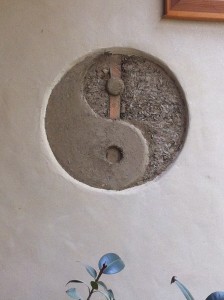 it reveals the true nature of the wall itself. You can see all the various components – the cob, the support beam, the brown plaster, and finally the top plaster. This particular window was done in the shape of a yin yang to promote a sense of balance within the home.
it reveals the true nature of the wall itself. You can see all the various components – the cob, the support beam, the brown plaster, and finally the top plaster. This particular window was done in the shape of a yin yang to promote a sense of balance within the home.
We were so fortunate to have been able to see such an amazing house. It was incredible to see what can be accomplished with cob – through the same process that we had been a part of, something this beautiful can be made.

